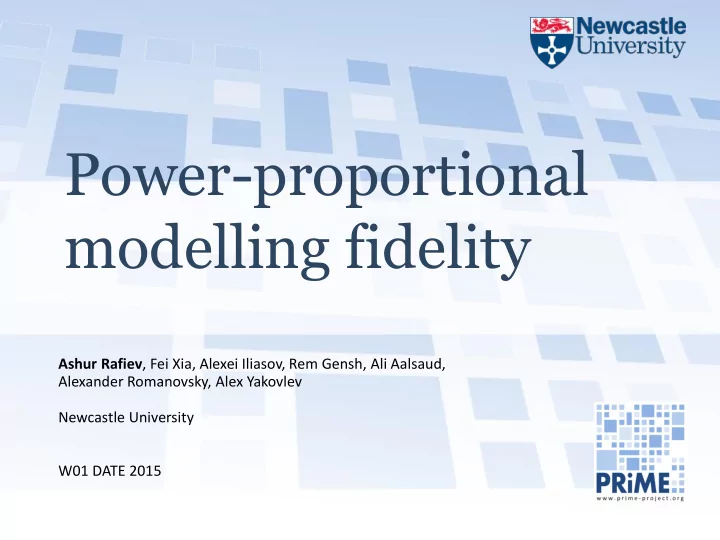

Power-proportional modelling fidelity Ashur Rafiev , Fei Xia, Alexei Iliasov, Rem Gensh, Ali Aalsaud, Alexander Romanovsky, Alex Yakovlev Newcastle University W01 DATE 2015
Motivation Modelling effort is becoming a bottleneck in many modern designs. State-space explosion problem. System complexity is coming from the level of details. Accuracy vs model complexity trade-off. In many cases it is over-engineered towards the worst- case scenario.
Motivation Modelling effort is becoming a bottleneck in many modern designs. State-space explosion problem. System complexity is coming from the level of details. Accuracy vs model complexity trade-off. In many cases it is over-engineered towards the worst- case scenario. – In this paper we propose an adequately balanced modelling towards the worst-case scenario.
Outline Parametric modelling: SANs. Experimental platform: ODROID XU3 Order Graphs – model hierarchies Cross-layer cuts – adjustable level of detail Back to example: ODROID XU3 + Order Graphs Proposed workflow Conclusions
Parametric modeling Parametric modeling is focusing on quantitative estimation of a set of (physical) parameters. This can be done using SANs (Stochastic Activity Networks). We use Möbius tool to edit and analyze SANs models. https://www.mobius.illinois.edu Disclaimer: the main contribution of the paper is not focused on SANs in particular and can be applied to other parametric modeling techniques.
Experimental platform: ODROID XU3
ODROID XU3 Heterogeneous platform based on ARM big.LITTLE: 4 high performance cores ( A15 ). 4 low power cores ( A7 ). Same SoC as in Samsung S4. Power sensors for each power domain.
ODROID XU3 A15 consumes 4-10 times power per computation compared to A7. Measuring resolution is 0.02mW for A15 vs 0.003mW for A7.
ODROID XU3 A15 consumes 4-10 times power per computation compared to A7. Measuring resolution is 0.02mW for A15 vs 0.003mW for A7. Does it make sense to model A7 to the same degree as A15?
Order Graphs Resource-driven modeling. Modeling hierarchies. Cross-layer modeling.
Resources and dependencies Any system is represented as a Resource graph: - nodes are resources, - edges are dependencies between them. Types of resources: Hardware Logic, Memory, Energy, Task, Thread, etc... Anything can be a resource. Types of dependencies: Energy dependency, Data dependency , and other...
Hierarchical Modelling Layers of abstraction: Graphs k and k+1 model the same system S, but to a different level of details.
Hierarchical Modelling Together they form a hierarchy. Each node is a sub-graph in the lower level. Notions of Verticality and Horizontality (first introduced by G. Rozenberg [5])
Hierarchical Modelling New in Order Graphs : Some edges become nodes in the lower levels of abstraction, which means that the dependency is ensured (supported) by a resource. Also, consistency checking rules.
Cross-layer cuts Cross-layer cut is an obtained flat (graph) model combining elements from different layers of abstraction while preserving connectivity properties.
Platform model in Order Graphs
Power-proportional modelling fidelity
Power-proportional modelling fidelity
Power-proportional modelling fidelity Each node in the graph has an associated SANs module. Möbius tool can merge these modules into a complete SANs model of a system. 1/4000 state-space reduction.
Structurally we do not model the system to the same level of details. Parametrically we do model the system to the same level of precision.
Proposed Workflow Note: can also be applied to runtime model adaptation.
Conclusions We propose a systematic approach for power-prortional (parametric-proportional) modelling, which is based on building cross-layer cuts. Future/current work: tool support – graphical editing, formal proving (via integration with Event-B).
Conclusions We propose a systematic approach for power-prortional (parametric-proportional) modelling, which is based on building cross-layer cuts. Future/current work: tool support – graphical editing, formal proving (via integration with Event-B). Use flat models on parameters. Do not use functionally (structurally) flat models.
Thank you!
Recommend
More recommend